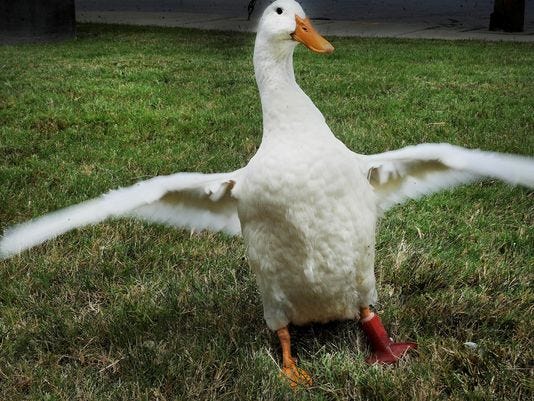Buttercup also caught the attention — and a donation — from an insurance company with its own duck mascot.

(Photo: John Partipilo, The Tennessean)
Buttercup the peg-legged duck showed off his new webbed foot Tuesday, waddling into the hearts of workers who helped make his new prosthesis a reality.
The domestic white duck, born last year with a backward left foot, had it amputated earlier this year because it would bleed as he tried to walk on it.
STORY: Disabled duck walks on new foot
Mike Garey, a volunteer at Feathered Angels Waterfowl Sanctuary in Arlington, Tenn., knew the best way to give Buttercup a normal duck life was to find a way to fashion an artificial foot that faced the proper direction. Buttercup had the new foot attached Sunday night and within minutes was walking around outside on sanctuary grounds.
"There was always the big unknown of whether or not it would work and if he would accept it," Garey said.
But Buttercup had no problems accepting his new bright red, rubbery foot, and the lucky duck came to Nashville with his keeper Tuesday to say thank you to friends and fans.
Garey and his sanctuary got Buttercup after he was hatched last year in a high school biology lab. A veterinarian amputated his foot in February, and as Buttercup's stump healed, Garey began researching options for a new foot.
The first step in Buttercup's custom-made prosthesis was a prototype created with a 3-D printer. Garey chose NovaCopy here, about 200 miles from the sanctuary, because of the company's expertise and high-resolution technology. Officials agreed to donate their time, expertise and technology to the non-profit group.
"(Garey) was really looking for a donation of the 3-D printing services, and I said absolutely," said Melissa Ragsdale, NovaCopy's president of 3-D printing solutions. "I would do it again in a heartbeat."
The duck-foot prototype, which took NovaCopy 13.5 hours to print, helped Garey create a mold for the prosthesis. Then Garey made the prosthesis from the mold. A special stretchy sock slipped over Buttercup's peg leg allows the prosthesis to stay in place comfortably.
Joel Graves, the 3-D engineer who printed the prototype for Buttercup's foot, said he was amazed the first trial of the prosthesis worked.
Garey agreed. Ragsdale and Garey already have begun discussing refinements to Buttercup's prosthesis. A new hand scanner will allow Garey and engineers to scan the current foot then edit its design in a computer program.
"If he didn't like the prosthetic and wouldn't walk on it, it wouldn't have mattered how many times I changed it," Garey said.
Buttercup's rehabilitation from what was a life-threatening disability caught the eye of Aflac, the insurance company that has its own domestic white duck mascot recuperating from an injury. Kelsey Evert, Aflac's Middle Tennessee regional sales coordinator, presented a $3,000 check to Garey, Buttercup and Feathered Angels Waterfowl Sanctuary so volunteers can help other injured animals.
"It was a perfect fit for Aflac," Evert said. The promotional check was written to Buttercup and signed with footprints from the Aflac duck.
Graves, the 3-D printing engineer, often works on manufacturing projects and even some medical projects. He said 3-D printing sometimes gets a bad rap because of the media's focus on the printing of functioning plastic guns that can slip through metal detectors.
But that isn't the point of the technology, he said. The point is to help people — or even animals — improve the quality of their lives.
"It's extraordinary to work on something that will actually benefit someone, even if that someone is a duck," Graves said. "It could be a person benefiting like this in the future."




0 comments:
Post a Comment